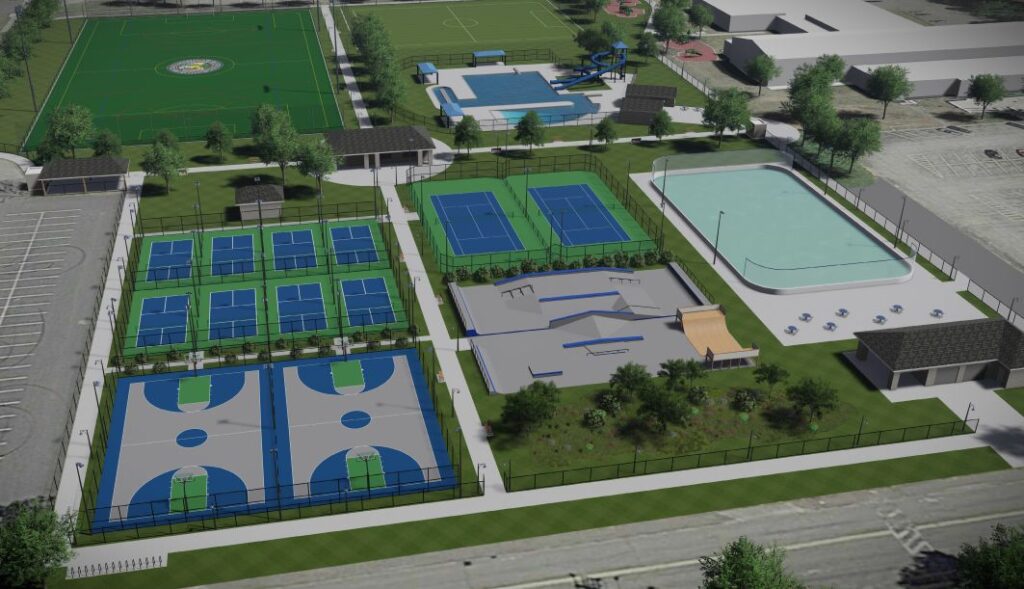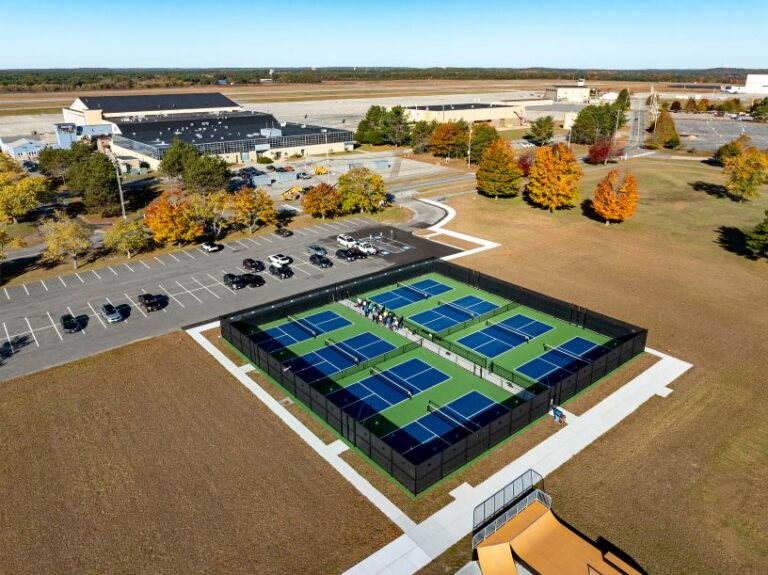By Michael Moonan, RLA, LEED AP
For municipal leaders and recreation professionals, the demand for pickleball courts is outpacing supply – creating both a challenge and an opportunity. Sports designers and landscape architects play a key role in addressing these demands with strategic planning and site selection. The following are smart design solutions to help communities meet the pickleball boom head-on.
Pickleball popularity
The sport has experienced exponential growth, with USA Pickleball (USAP) reporting a membership increase from 4,000 in 2013 to nearly 78,000 as of January 2024. The number of known pickleball courts in North America has also risen dramatically. The USAP court location database, Pickleheads, now includes 68,458 courts, with 18,455 new courts added in 2024. This growth is attributed to the sport’s appeal across various age groups and adaptability to different playing environments.
Planning phase considerations
When planning a pickleball facility, it is crucial to assemble a diverse team that includes design professionals, court builders, local players and municipal leaders, if applicable. This team can provide valuable insights into the needs of different user groups, such as adults, seniors and children. Additionally, ensuring compliance with zoning, permitting and ADA requirements is essential to meet all legal standards.
It’s important to ask critical questions during the planning phase:
- Will the courts be used primarily by adults or seniors?
- Will children also use the courts?
- Will there be spectators, tournament play or other uses?
- Do you have enough users to justify dedicated courts?
- Should the courts be covered with a canopy?
Different groups of users will have varying desires, needs and requirements. By addressing these questions and considering the diverse needs of potential users, you can create a facility that serves the community effectively and inclusively.
Overall playing area
The court area is a 20-foot-wide by 44-foot-long rectangle for both doubles and singles matches. The American Sports Builders Association (ASBA) and USAP recommend the following overall sizes for playing areas:
- Recreational play: Minimum total recreation/drop-in play area is 30 feet by 60 feet.
- Competitive play: Recommended total playing area for competitive/ tournament play and new construction is 34 feet by 64 feet.
- Wheelchair play: Recommended total playing area for wheelchair play is 44 feet by 74 feet.
- Stadium play: Recommended total playing area for a stadium court is 50 feet by 80 feet.
During the design input process, we found that players preferred the competitive-sized court, given their increased movement and the ability of players. Some players feel the standard recreation size is too small, with insufficient overrun at the sides and backcourt for playability and safety. In several of our recent projects, the community requested the competition size since they had been playing on the standard recreation size and found it insufficient.

Court building trends
In recent years, the landscape of court building has seen exciting and innovative trends, especially in pickleball. New facilities are emerging in non-traditional locations, transforming unexpected spaces into vibrant pickleball hubs. Existing hard courts are being converted to pickleball courts, maximizing available space and resources. Where space allows, adding bays of pickleball courts to existing tennis locations helps avoid conflicts with tennis players.
Multi-court facilities, which include basketball, tennis and pickleball courts with shared social areas, are also gaining traction. These versatile complexes cater to various sports enthusiasts and foster community engagement. Additionally, older indoor gyms are being repurposed for pickleball, providing weatherproof environments for year-round play.
These trends reflect the dynamic nature of court building, driven by the growing popularity of pickleball and the desire to create inclusive, multi-functional recreational spaces.
Siting pickleball courts
Siting pickleball courts involves careful planning to ensure optimal playability, safety and visibility. A flat, level surface – preferably asphalt or concrete – is crucial. The court should be oriented north-south to minimize sun glare. Adequate surrounding space for players and spectators is also essential.
For the surface, choose a hard surface such as asphalt, concrete or synthetic. The official court size is 44 feet long by 20 feet wide. Consider adding extra space around the court for player movement and spectators. A minimum total play area of 30 by 60 feet is recommended by USA Pickleball, with a 10-foot surrounding margin ideal.
Other things to consider when locating pickleball courts include, but are not limited to:
- Existing facilities and constraints
- Reuse of existing courts (most sustainable process)
- Location in the community
- Accessibility – ADA and general access/distance to available or proposed parking
- The need for additional walkways to the courts for players and spectators
- The need for additional parking
- Noise concerns
- Proximity to abutters
- Potential conversion or ease of implementation
- Surface and subsurface considerations
- Need for landscaping or buffer areas
- Wind considerations
- Available utilities or new infrastructure
- Access for construction vehicles
- Number of courts that will fit on the site
As mentioned previously, reusing existing underused courts or incorporating pickleball courts into an existing facility where other athletic venues exist can be the most cost-effective and sustainable solution for adding pickleball courts. When courts are added to existing facilities, there may be a potential need for added infrastructure such as parking, pathways, support buildings, shade shelters or other amenities. However, if these elements are not already available, it could also present an opportunity to add much-needed support features to an existing park. Creating a new facility would require adding some or all of these elements to the project. As with development practices, using an already disturbed site where pavement and buildings exist is also sustainable and beneficial. It may require added cost for building demolition and site preparation; however, it is an environmental win anytime you can use an abandoned or converted developed site rather than taking away farmland or woodland.

Sound considerations
Sound considerations are among the most critical aspects when planning and locating pickleball courts. Throughout the United States, there have been several instances where courts were placed too close to residences, leading to serious complaints and, in some cases, closure of the courts. Pickleball can be noisier than tennis due to the ball’s higher pitch and the game’s social nature.
To mitigate sound issues, several strategies can be employed:
- Distance: The most effective mitigation strategy is maintaining sufficient distance. Courts should be kept at a safe distance from residences, offices, schools, daycare facilities and similar locations.
- Existing elements. Natural and built elements such as woodlands, walls, terrain and buildings can provide sound buffering and should be considered when siting the courts.
- Acoustical barriers: Installing barriers such as Acoustifence or FenceScreen can reduce noise by up to 50 percent.
- Quiet equipment: Requiring or recommending the use of quieter paddles and balls can help achieve acceptable sound levels in residential areas; however, it is difficult to enforce this with public courts.
- Community engagement: It is important to confirm that the adjacent property owners are well aware of the project and its impact.
The latest ASBA and USAP recommendations suggest that pickleball courts should not be allowed within 100 feet of residential buildings. Within 350 feet, noise abatement measures should be installed; within 600 feet, an acoustic review should be conducted. At 400 feet away, pickleball noise is generally 58 dBa, comparable to the noise level of tennis.
A Model Noise Ordinance for Pickleball, prepared by the Noise Pollution Clearinghouse using the U.S. EPA Model Noise Ordinance as a basis, provides valuable guidance. It states:
“While the model language provides a number of tools to regulate pickleball noise, from decibel levels to plainly audible to time-of-day requirements, the primary and easiest method to protect the health and well-being of neighbors is to adopt a setback from dwellings of 800 feet.”
Too often, communities replace existing tennis courts with pickleball courts immediately adjacent to residences without adequate planning or consideration, causing serious conflicts and concerns within the community.
Converting existing courts
The most sustainable and cost-effective solution to meet the growing demand for pickleball courts is to convert existing tennis courts to pickleball courts. This approach not only maximizes the use of available space, but also minimizes the need for new construction. Conversion can be done in several ways:
- One pickleball court per tennis court: Center the markings on the net and court, and lower the tennis net to 34 inches in the center.
- Two pickleball courts per tennis court: Utilize temporary nets (or permanent with new post footings) to fit two courts within the standard tennis court dimensions.
- Four pickleball courts per tennis court: Four pickleball courts conveniently fit in one standard-size tennis court (60 feet by 120 feet). Divide a standard-size tennis court into four smaller courts, often requiring the squaring off of diagonal corners if present.
Budget considerations
When budgeting for pickleball courts, consider factors such as fencing, sound attenuation, lighting, walkways, seating, access, parking and compliance with ADA requirements. Additionally, the delivery method (design-bid-build, design-build, direct hire or self-perform) can impact the overall cost and timeline of the project.
Other considerations
When planning a pickleball facility, several factors must be considered for functionality and compliance. Decide on installing or replacing a perimeter fence; determine height requirements; and consider the need for wind screens, as wind can affect playability. Ensure access for construction vehicles and walkways for players and spectators. Compliance with ADA and other relevant requirements is essential.
Consider seating for spectators and players waiting to play, and plan for lighting on the courts and surrounding areas. Consider amenities such as picnic areas, shade shelters and water stations. Landscaping or buffer areas can enhance the environment, and sound walls may be necessary if the facility is near residences.
Finally, choose the appropriate delivery method — design, bid, build, design-build, direct hire, self-perform or a combination — to ensure successful project execution.
By addressing these considerations, planners can create a welcoming and well-rounded pickleball facility.
As the popularity of pickleball continues to rise, innovative court design solutions are essential to meet the growing demand. By considering various court types, conversion strategies, sound mitigation and budget factors, communities can create accessible and enjoyable pickleball facilities for all players.
Michael Moonan, RLA, LEED AP, is a senior landscape architect at CHA Consulting, Inc., with expertise in parks, sports and recreation design. He oversees all phases of project development – from master planning and conceptual design to construction administration through completion. His experience includes public and private K-12 schools and communitywide and single-site recreation master plans. He is an active member of ASBA, USA Pickleball, and the Sports Field Management Association member. He can be reached at MMoonan@chasolutions.com.
References:
- American Sports Builders Association/USA Pickleball. (2020). Pickleball Courts: Construction & Maintenance Manual. https://sportsbuilders.org/page/OnlineStore
- USA Pickleball. (2024, January). 2023 USA Pickleball Annual Facts and Highlights. https://usapickleball.org/about-us/organizational-docs/pickleball-annual-growth-report/
- USA Pickleball. (2023). Official Pickleball Rulebook – 2023 Edition. https://usapickleball.org/what-is-pickleball/official-rules/

